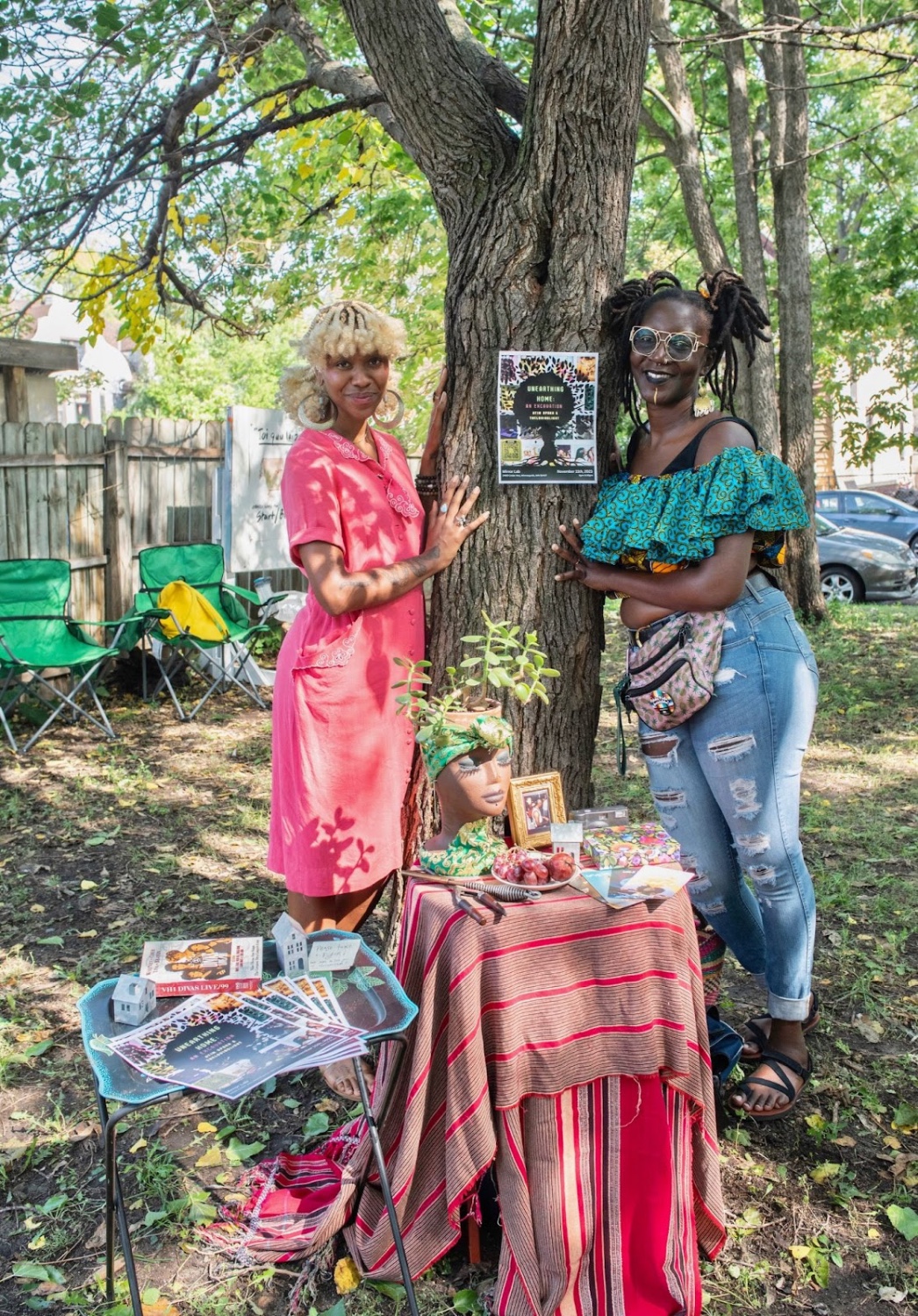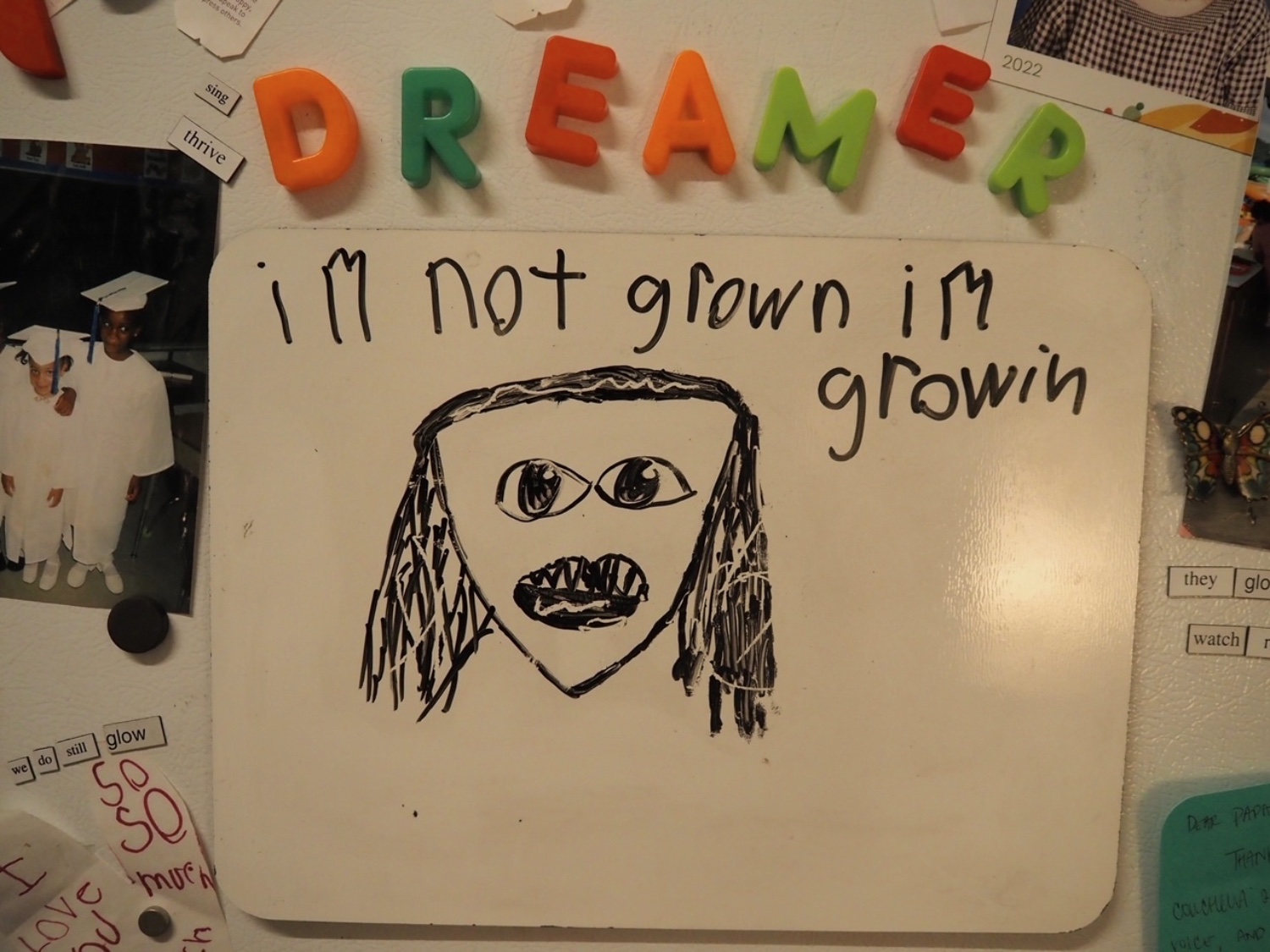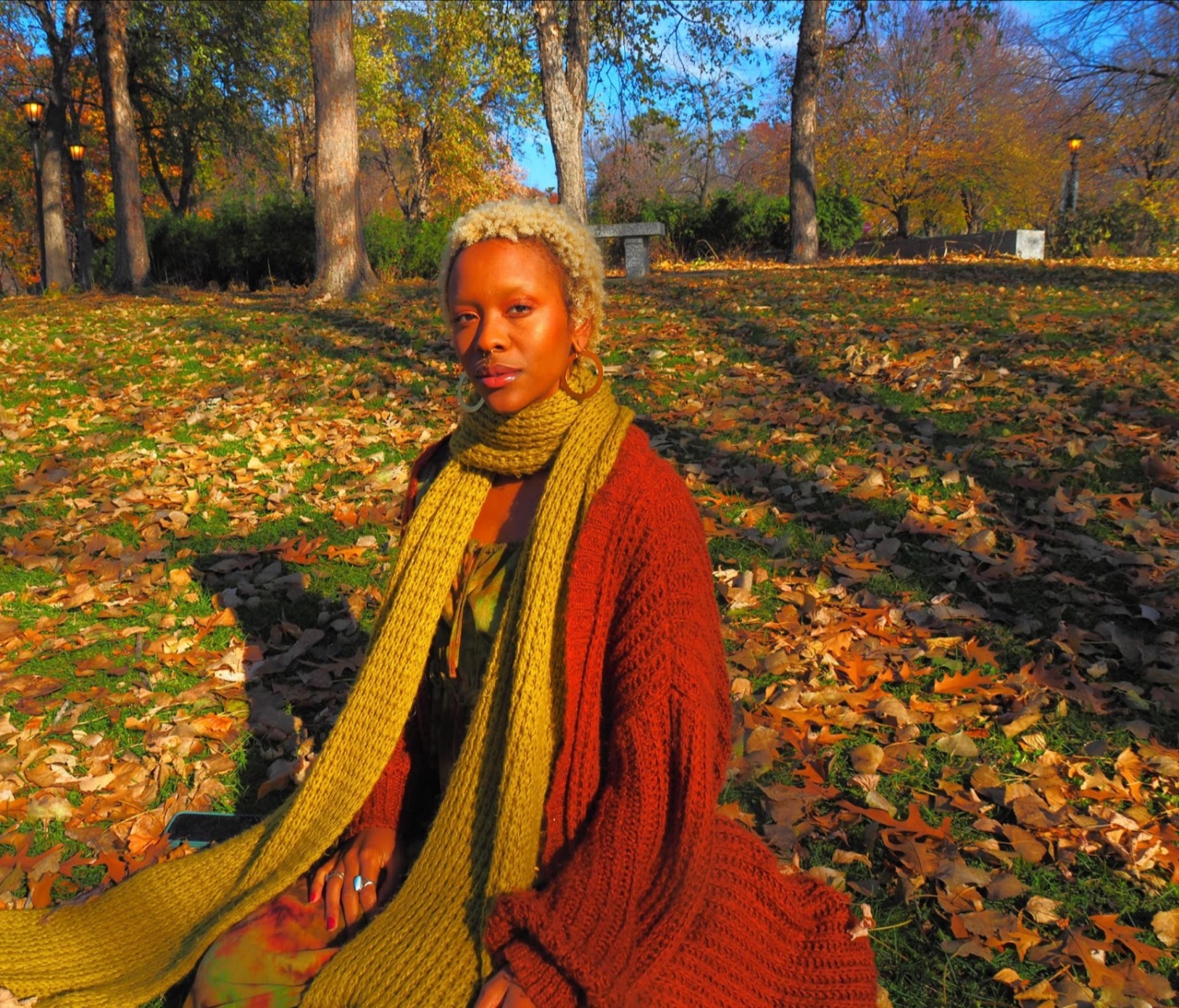
Unearthing Home at Mirror Lab: Q&A with Papaya Evermore
Published November 6th, 2023 by Pauline Moll
The one-night-only immersive installation on November 11 centers Black belonging within the art world and the natural world beyond it
Writing for MPLSART.COM about visual arts, I cannot help but reveal my theater background through my unabashed love for temporal, experiential visual arts experiences. When Papaya Evermore (she/they), known artistically as The Loving Light, told me her new art installation is “not so much an art show — it’s an immersive experience,” I was giddy with curiosity.
Defying genre and Eurocentric artistic conventions, Papaya and their collaborator Atim Opoka (they/them) present Unearthing Home: An Excavation, a one-night-only experience where the artists become nurturers and the viewers become community members. I spoke with Papaya to hear more about the nature-based, multi-sensory, come-as-you-are installation and Papaya’s artist self.
 Papaya Evermore (The Loving Light) and Atim Opoka. Images courtesy of the artist.
Papaya Evermore (The Loving Light) and Atim Opoka. Images courtesy of the artist.
Pauline: What is Unearthing Home?
Papaya: It was birthed through an artist cohort that myself and my collaborator, Atim Opoka, were in through Hope Community. Atim and I had artist crushes on each other! We decided to create this collaborative project. The exploration is to get into: what is home, where is home, how do you know that you’ve made it home? I’m a person who has always straddled a lot of lines. I haven’t always felt at home in the world or in my family dynamic. I have always found myself seeking belonging. Now, I’m having the audacity to claim home and having the courage to say, “I don’t know what home means to me all the time.” Through this work and this container, I’m calling like-minded souls who are also making their way back to themselves to come be held in a space where they can explore that.
Pauline: That definitely resonates for me and for so many of us BIPOC in diaspora.
Papaya: Even if you don’t know where you belong as far as being a human in relation to other humans, we’re all humans and we all belong to the earth. I belong to the river, I belong to these trees. That’s why it’s important for me that the place includes themes of nature, mother earth, a lot of the work in this place will be an infusion of our humanity and our inherent belonging to mother earth. There’s a lot of found object work made from nature.
Pauline: Wow, that’s so beautiful and hopeful.
Papaya: Yes! Art continuously saves me from despair [laughing]. I have only been claiming the title of artist for like a year now, so this is all so new for me. That audacity I’m talking about, I’m really calling that forth right now to claim my space, because art has continued to save me. When you look around my home, you see the origins of the nature-based art, everything is something I’ve found in nature, found for free. The decor in my space is all natural and reminds me of this resourcefulness that I feel is inherent to my Blackness because we’re such a resourceful people and know how to use what’s at hand to create something beautiful. I’m grateful to be taking up more space in the world and continuing to expand my sense of belonging — belonging in self, belonging in the world, creating space for others to belong.
Pauline: That reminds me of what Sonya Renee Taylor calls “the technology of Blackness” — survival as a long-term skill, being able to see oneself in the future, knowing how to survive centuries of oppression, creating art and community and beautiful things in new iterations. Do you want to tell me more about how your Blackness influences your artistic work?
Papaya: Being Black, living on the fringes, being a lot more radical than my family of origin, it’s so important for me to create spaces where we can vision beyond the despair, displacement, and overwhelm to really dream together, what kind of spaces do we want to hold us? I have a deep desire to spark imagination around new visions of what home can be. We’re not tethered to the past. We have so much space to create anew. I find a deep longing to be in those conversations with people. I don’t get enough of that when I’m viewing art. I often don’t often feel seen in art spaces where I’ve been.
Pauline: Can you tell me about those art spaces where you don’t feel seen?
Papaya: The spaces that don’t feel welcoming to me are spaces where I feel my whole self isn’t engaged with. Meaning, there’s only a part of me that’s welcome in that space. Maybe it’s the consumer part who gets dictated what to think, feel, what I should make of it all, rather than calling forth my creativity and my engagement with the art in a way that is expansive and creative. I’ve been in a lot of spaces where my presence is commodified. I think we sometimes pander to one another, maybe coming from a desire for that sense of belonging. I think we want people to have a certain experience, so we create spaces that are a bit stiff and don’t have room to engage.
Pauline: What kind of art spaces would you like to see instead?
Papaya: I really appreciate when artists are in the space engaging with the theme, when they’re in the art. One example was Affirmation Space over in Public Functionary last year. It was by Bayou Bay, and he absolutely lived in that space. I feel very inspired by how he holds space. The way he thought about how folks would want to feel in the space with so much expansiveness. He created so much coziness! You could come and sit and read and journal and engage with the prompt in your own space. Kids were swinging from hammock swings fixed into the ceiling and jumping on beanbags, there was incense, he really thought about what it would feel like to be in that space as a whole person who needs time to play, to connect. It was magic.
Pauline: That sounds like so much fun. I want to swing from the ceiling!
Papaya: Right! When I see good art, the child in me gets so excited. When I go see art, I want to try to take the shape of the sculpture. [In arts spaces] there are usually rules of engagement or rules around civility. I don’t want people to be policed or scrutinized in spaces I hold. You’re trusted in this space to move how you move, to be seen and celebrated as you are. I’m so adamant that we are all growing right now. To quote my 8-year-old daughter, Amia, “I’m not grown, I’m growin.” There are no grown-ups, we’re all just growing. I’m interested in creating spaces where my innocence and childlike spirit feels held and it feels like sanctuary. Space where’s it’s safe to fall apart and shed a tear, but also there’s guidance and holding for the reformation process and coming together and creating anew.

Pauline: Say more about that — how do you want to invite people to show up to Unearthing Home specifically?
Papaya: I want folks to show up as they are, whole. Full of curiosity, full of questions, and carrying whatever wisdom their lives have offered them to share. There will be ways for folks to engage in the space such as prompts people can answer and leave hanging from the walls, places where people can take photos. Folks can simply lay down and be in the space and just take in the sounds in the sound bath and be held and find comfort in their own bodies. I want people to come into the space with a playful energy ready to experience something new. I want them to know that there are no rules for how to engage with this art, and I’m trusting everyone’s instincts and everyone’s nature to come in.
Pauline: What else can people expect from this space?
Papaya: So, Mirror Lab is a gallery in Powderhorn. It’s a total blank canvas that we’re going to transform. It’s giving fairycore energy [laughing] and Afrofuturist energy. In the space there will be projected art, nature-based art, flowers, tree branches, things of this nature. There will be altars because spirituality is a big part of my life and how I offer, so there will be a presence of God in the space. While it is in a gallery, it’s not so much an art show, it’s an immersive experience. Nothing is for sale. It’s really an immersive experience where people get to step into our world, step into our interpretation of home. There will be poetry on the walls, there will be food that we’re making ourselves, giving everyone the homey treatment.
Pauline: Is there anything else you want the world to know?
Papaya: I would say that for me, the creation of this work is an act of courage. I am an emerging artist cultivating the strength to share my authentic voice. As a Black mother, I know my creative power, and now I’m in the phase of showing and sharing my creative power. I really want to say that because I feel sometimes when folks view art or come into spaces, there isn’t enough grace given and enough acknowledgment of the humanity of the artists. I want folks to know I am a work in progress. And I’m just so grateful for the opportunity to utilize these gifts that God has given me to create and to share. This feels like a pilot for what I want to continue to expand upon as I gather more resources to create offerings. It’s gonna get more rich, more explorative, and more lived in along the way. ◼︎
 Papaya Evermore (The Loving Light)
Papaya Evermore (The Loving Light)
From the artists: Unearthing Home: An Excavation is a collaborative, multimedia art installation between The Loving Light (aka Papaya Evermore) and Atim Opoka. A few of the themes of exploration for the evening are belonging to ourselves and one another, finding home in ever changing landscapes of chaos, ancestral connection, reclaiming our soul connection to soil and how to deepen relationship with mother earth — the home we all share. There will be live music, food, open-hearted conversation, and a sound bath to close the night.
Unearthing Home will be on view Saturday, November 11 from 6-8:30pm at Mirror Lab, 3400 Cedar Ave in Minneapolis. For more information, visit Unearthing Home on Instagram @unearthinghome_. You can follow The Loving Light on Instagram @iam_thelovinglight and listen to their podcast, How We Stay Free, on Spotify.
This activity is made possible by the voters of Minnesota through a grant from the Metropolitan Regional Arts Council, thanks to a legislative appropriation from the arts and cultural heritage fund. 
We can't do it without you.
Help keep independent arts journalism alive in the Twin Cities.